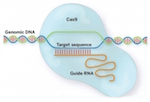CRISPR/CPF1: New Simpler CRISPR Protein May Cut Patent Fights Short

New CRISPR discovered by original CRISPR/Cas9 discovery team promises simpler and more flexible gene editing with fewer legal tangles.
Broad Institute Researchers at Massachusetts Institute of Technology, the same one’s originally involved in the Cas9 discovery, combed through hundreds of bacterial CRISPR systems in the hopes of finding another natural gene editing system. They found not one, but two of the same enzyme systems. The Cpf1 system was found in two bacterial species Lachnospiraceae and Acidaminococcus, where it performs almost the same functions that Cas9 does, albeit a bit better with fewer resources.
The originally discovered CRISPR/Cas9 system has been engulfed in patent disputes ever since its announcement in 2011. Broad Institute of MIT and the University of California, Berkeley are involved in a fierce patent battle involving this revolutionary gene editing technology that has taken laboratories by storm. Many companies have jumped into the CRISPR bandwagon backed by the Universities and their respective founders Dr. Zhang Feng and Dr. Jeniffer Doudna with Dr. Emmanuelle Charpentier. Losing the fight could mean the loss of a potential Nobel Prize for its discovered and even millions in royalties from companies founded on CRISPR/Cas9 technology. The technology is currently in various stages of in-vitro and in-vivo applications to bring new precision therapeutic drugs to the market, not to mention upwards of 2000 research papers already published.
In a paper published in Cell titled, “Cpf1 Is a Single RNA-Guided Endonuclease of a Class 2 CRISPR-Cas9 System” the researchers led by Feng describe in detail the new Cpf1 enzyme system and its key differences from Cas9.
Key Differences between Cas9 and Cpf1
|
Cpf1 |
||
| Structure | Double RNA system | Single RNA system |
| Cutting Mechanism | Blunt End Cuts | Exposed End Cuts |
| Cutting Site | Close to Recognition Site | Far Away from Recognition Site |
| Target Sites | Cas9 PAM Sites | Cpf1 PAM Sites (T-rich protospacer adjacent motif) |
| Kind of Cells | Fast growing Muscle and Cancer Cells | Non-dividing Nerve Cells and Malaria Parasite |
Compared to Cas9, Cpf1 has just one RNA structure making it easier to deliver cells in-vivo and its flexibility in cutting away from the recognition site will give researchers the ability to edit genes with no nearby recognition sites.
Zhang’s team plans to spread the knowledge and tools for Cpf1 system widely, through plasmid sharing websites like Addgene and their own website at http://www.genome-engineering.org. While this discovery might not bring an end to the Cas9 patent dispute, it will give researchers wider range of tools to choose from when working with different cells of the body. It could although give Broad Institute a backup in case things go south with the patent lawsuit proceedings.
Source: Zetsche et al., Cpf1 Is a Single RNA-Guided Endonuclease of a Class 2 CRISPR-Cas System, Cell (2015), dx.doi.org/10.1016/j.cell.2015.09.038


